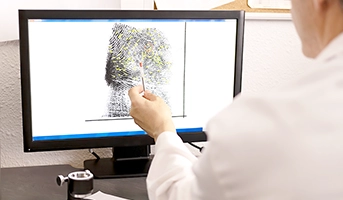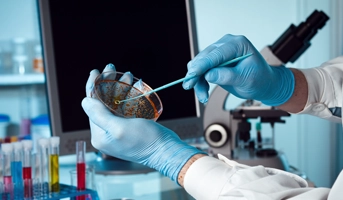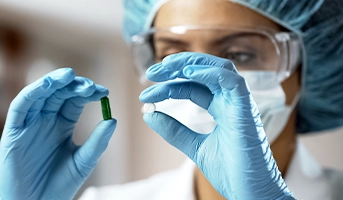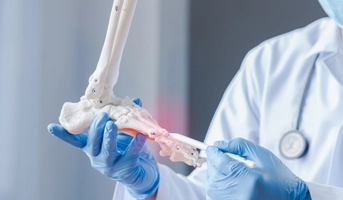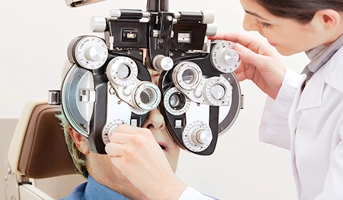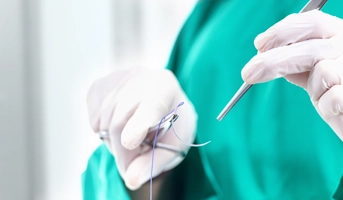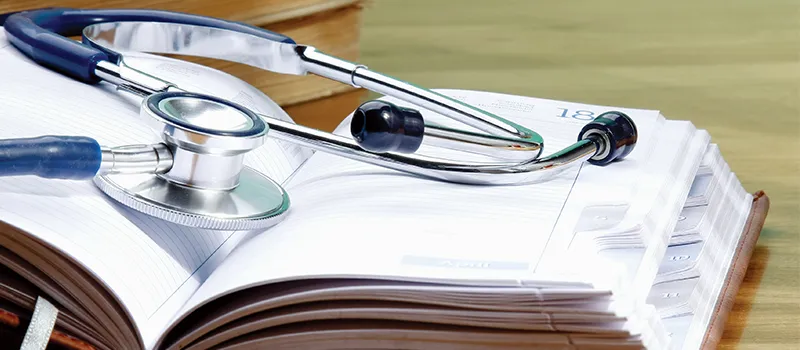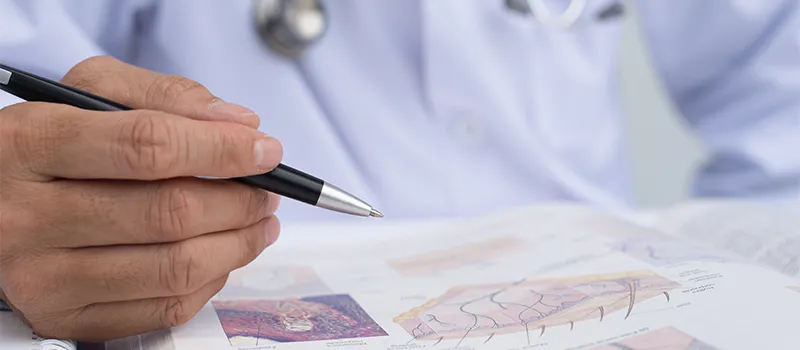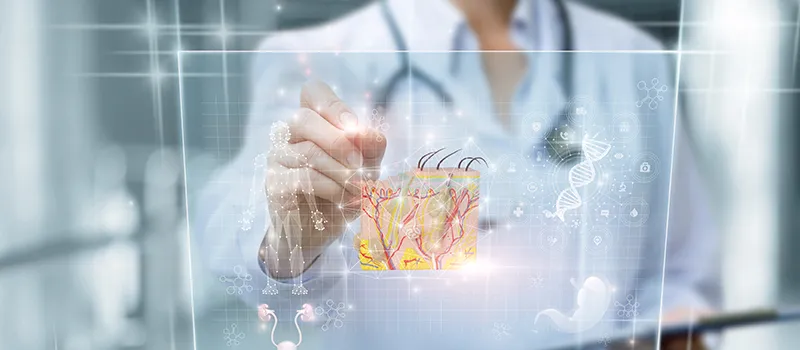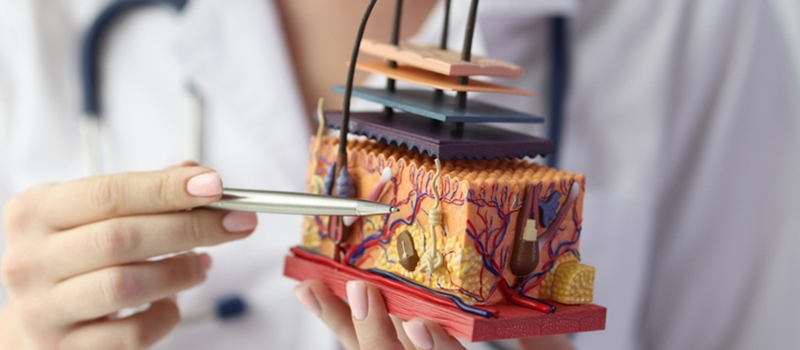

Dermatology: Important Topics and Preparation Tips
Dermatology is a medical discipline concerned with the diagnosis and treatment of skin, hair, nail, and membrane conditions and disorders.
In MBBS, the curriculum of Dermatology, Venerology, and Leprosy subject includes the causative and risk factors of dermatological conditions along with detailed treatment and preventive measures. Identification, categorization, etiology, microbiology, pathogenesis, natural history, clinical features, presentations, complications, indications, and contraindications of skin, nail, and hair conditions are all included in the dermatology subject. Also, pharmacological administration and adverse reactions of pharmacotherapies are discussed.
Dermatology is a highly booming medical speciality, hence having a comprehensive knowledge of the subject paves the way to a successful career if you are aspiring to be a dermatologist.
Knowing high-yield topics, subject weightage in competitive exams, and reliable preparation tips help in gaining conceptual clarity over a subject and maximise your chances of getting good grades.
In NEET-PG, 6-8 questions are asked from the dermatology subject, and in INI-CET, the subject weightage of the dermatology subject is around 5-6 questions.
Important Topics of Dermatology in MBBS
These topics are important for MBBS prof exams as well as are high-yielding topics for NEET-PG and INI-CET.
Structure of Hair
Basics of Dermatology
Cells of Epidermis
Level of Epidermis
Drug Eruptions
Lepra Reactions
Photosensitivity
DDs of Bullous Lesions
Sexually Transmitted Viral Infections
Angioedema
Sebaceous Gland
Blistering Disorders
Chemical Peeling
Pigmentary Disorders
Structure of Sweat Glands and Related Disorders
Skin Lesions
Treatment of Acne Vulgaris
Deep Folliculitis and Cellulitis
Mucocutaneous Manifestations of SLE
Histopathological Findings
Basement Membrane Zone
Dermis and Subcutaneous Layer
Bacterial Infections
Fungal Infections
Mycobacterial Infections
Viral Infections
Structure of Epidermis and Dermis
Patch Test
Histopathology of PV
Oral Retinoids in Acne
List of Important Dermatological Conditions
Erythema Multiforme
Kaposi Sarcoma
Lichen Planus
Tinea Infections
STDs
Papulosquamous Disorders
Skin Tumors
Secondary Syphilis
Hepatic Fibrosis
Skin Lesions in Systemic Diseases
Allergic Dermatitis
Chikungunya Pigmentation
Ulcers
Vesicollous Disorders
Scleroderma
Urticaria
Alopecia
Clear Fluid Lesions
Secondary Skin Lesions
Nikolsky Sign
Pemphigus Vulgaris
Tzanck Smear
Bullous Pemphigoid
Dermatitis Herpetiformis
Syphilis
Anogenital Warts
Chancroid
Donovanosis
Lymphogranuloma Venereum
Telogen Effluvium
Nail Psoriasis
Stratum Corneum
Genital Herpes Simplex
Toxic Epidermal Necrolysis
Psoriasis and its Treatment
Scabies
Atopic Eczema
Pityriasis Rosea
Kerion
Sporotrichosis aka Rose Gardener’s Disease
Chromoblastomycosis
Lupus Vulgaris
Scrofuloderma
Papulonecrotic Tuberculid
Hansen’s Disease
Mid-Borderline Leprosy
Verruca Vulgaris
HPV Infections
Molluscum Contagiosum
Melasma
Mongolian Spot
Nevus of Ota
Piebaldism
Segmental Vitiligo
Phrynoderma
Pellagra
Malignant Melanoma
Basal Cell Carcinoma
Acanthosis Nigricans
GI Adenocarcinoma
Glucagonoma
CA Lung
Discoid LE
Carpet Tack Sign
Dermatomyositis
Must Read: Important Topics of Medicine in MBBS
Must Read: Important Topics of Surgery in MBBS
Tips to Study Dermatology in MBBS
Dermatology is challenging but also a rewarding experience, opening doors to the fascinating field of medicine.
For a comprehensive study of dermatology, follow the described study pattern and reliable tips.
According to the new curriculum, the Dermatology subject is now included in the Medicine subject but is a diverse field of study in itself. It is highly fascinating if you learn in a structured way with images.
To start with the study, firstly get the syllabus and list of dermatological conditions included in the curriculum. Start with the fundamentals of dermatology and understand every basic terminology. Then go on to learn the concepts and dermatology topics. Categorise the types of dermatology diseases, disorders, and conditions. Further, learn the basic history taking, and understand common dermatology procedures, and techniques. After understanding all the concepts and procedures, refer to the syllabus and list of conditions and disorders included. Understand and learn them one by one.
Remember to study from the standard textbooks and dermatology atlases and that too, the latest edition.
Dermatology concepts are very well understood with high-quality images that aid in visualizing various skin conditions, hence, learn using images, spotters, and flashcards.
Practice IBQs and image-based clinical cases as much as possible after reading a concept. This will enhance your understanding of the topic and you will be able to memorise it for a long time.
Make sure to take proper notes with tables, flowcharts, mnemonics, flashcards, and more. Notes prove highly beneficial for revision and at the time of exams, may it be prof exams or any competitive exams, they serve as a ready reckoner.
Another thing to keep in mind while studying is to read the following for all the dermatological conditions and make a note of it: etiology, causative agents, risk factors, types, pathogenesis, clinical features, indications, contraindications, treatment, pharmacology, and preventive measures.
Try to categorise and learn accordingly to ease the learning process and improve retention. This also avoids confusion at times.
As the dermatology branch is being highly explored, don’t miss to read about the latest treatment modalities and cosmetic dermatology procedures being introduced.
You can’t ignore the importance of hands-on experience for recognizing and diagnosing skin conditions hence, actively participate in clinical sessions and rotations. Observe and practice. Try to correlate theoretical knowledge with real-life cases, and discuss with your fellows and professors.
To ease your learning process, you can complement your textbooks with online resources. Subscribing to a good online course would be of great help. You will learn from top faculty along with getting access to illustrative lectures, notes, and a lot more.
Quick Tips:
- Attend lectures and take proper notes.
- Actively participate in clinical sessions.
- Invest in best-selling titles.
- Refer to dermatology atlases.
- Complement your textbook learning with online resources.
- Actively engage in clinical rotations and postings.
- Attend conferences, seminars, and workshops.
- Practice questions and clinical cases.
- Use flashcards, mnemonics, and other memory aids.
- Stay organized.
- Stay updated on clinical guidelines for the management of dermatological conditions.
- Solve previous year’s questions.
Remember, consistency and dedication are key when studying dermatology or any medical specialty.
Best Books for Dermatology
Review of Dermatology by Saurabh Jindal is one of the best-selling dermatology books for MBBS students. The book is full of coloured images, mnemonics, memory aids, and conceptual diagrams. This exam-oriented book also includes a short review section at the end of each chapter.
IADVL’s Concise Textbook of Dermatology by Lalit Kumar Gupta is among the preferred books by MBBS students. The book is written in a lucid manner and the latest edition of it is comprehensively updated. The content is complemented with tables, flowcharts, figures, illustrations, and clinical photographs. The best part is that each chapter begins with a learning objective and the text follows a structured pattern, including MCQs and IBQs.
Fitzpatrick’s Color Atlas and Synopsis of Clinical Dermatology is a bestselling, concise, and quick reference book for medical students, residents, and physicians. The authors of the book are Arturo P. Saavedra, Ellen K. Roh, and Anar Mikailov. The latest edition is revised and expanded. The book includes over 1000 full-colour images and a color-coded 4-part organisation. It covers the most essential content along with detailed information on diagnosis and treatment.
Neena Khanna’s Dermatology book, Illustrated Synopsis of Dermatology & Sexually Transmitted Diseases, is a highly recommended book for studying the medical, surgical, and cosmetic aspects of STDs in depth. Each topic is easy to understand and organised with concise examples facilitated by real-life scenarios and cases.
Must Read: Best books for MBBS 4th year
Must Read: Psychiatry: Important Topics and Preparation Tips
Frequently Asked Questions (FAQs):
Q1. What is the subject weightage of dermatology in NEET-PG?
Ans. Dermatology is a medical discipline concerned with the diagnosis and treatment of skin, hair, nail, and membrane conditions and disorders. In NEET-PG, 6-8 questions are asked from the dermatology subject.
Q2. What is the subject weightage of dermatology in INI-CET?
Ans. Dermatology is a medical discipline concerned with the diagnosis and treatment of skin, hair, nail, and membrane conditions and disorders. In INI-CET, the subject-weightage of dermatology subject is around 5-6 questions.
Q3. What are the important topics in dermatology in MBBS?
Ans. The important topics in dermatology in MBBS include structure of hair, basics of dermatology, level of epidermis, drug eruptions, blistering disorders, skin lesions, acne vulgaris, bacterial infections, fungal infections, mycobacterial infections, erythema multiforme, lichen planus, STDs, papulosquamous disorders, skin tumors, syphilis, dermatitis, ulcers, urticaria, alopecia, nail psoriasis, genital herpes simplex, and scabies.
Q4. How to prepare dermatology for NEET-PG?
Ans. Here are some tips to prepare for dermatology subject for NEET-PG:
- Attend lectures and take proper notes.
- Actively participate in clinical sessions.
- Invest in best-selling textbook titles.
- Refer to dermatology atlases.
- Complement your textbook learning with online resources.
- Actively engage in clinical rotations and dermatology clinics.
- Attend conferences, seminars, and workshops.
- Practice questions and clinical cases as many as you can.
- Use flashcards, mnemonics, and other memory aids.
- Stay organized.
- Stay updated on clinical guidelines for the management of dermatological conditions.
- Solve previous year’s questions.
Related Courses
Cosmetic Botulinum Toxin Simplified
Dr Rasya Dixit , Dr Urmila Nischal , Dr K. C Nisch...
Critical Care Simplified
Dr Yatin Mehta , Dr Subhal Dixit , Dr Kapil G. Zir...
Advance Course in Ultrasound and Infertility
Dr Sonal Panchal , Dr Chaitanya Nagori
Ganga Videos on Spine Surgery
Prof Rajasekaran Shanmuganathan , Dr Ajoy Prasad S...
Pathology for UnderGrads
Prof Harsh Mohan , Prof Ramadas Nayak , Dr Debasis...
Microbiology for UnderGrads
Dr Apurba S Sastry , Dr Sandhya Bhat , Dr Deepashr...



